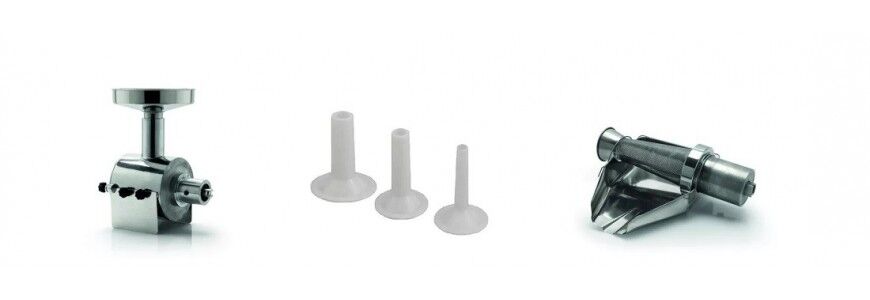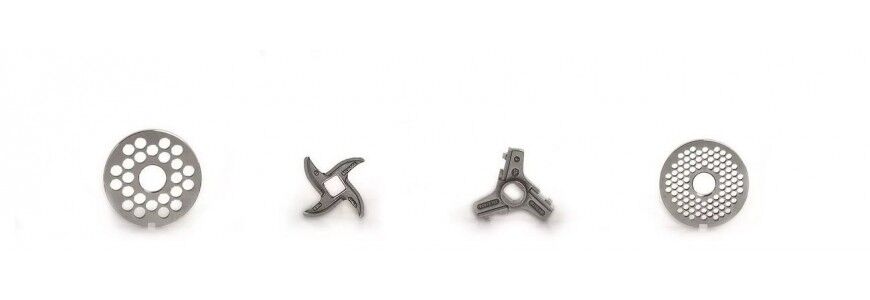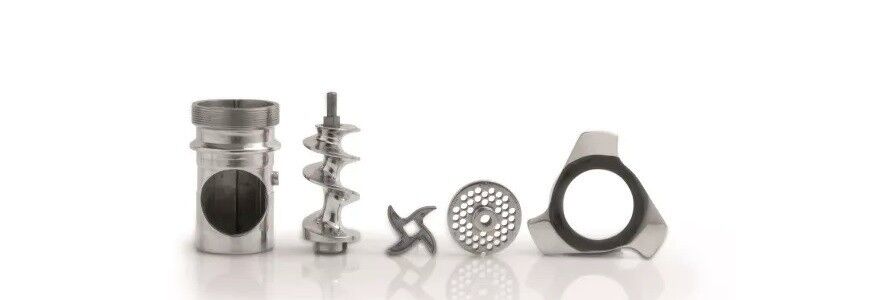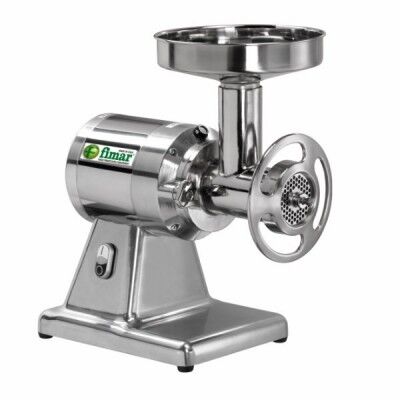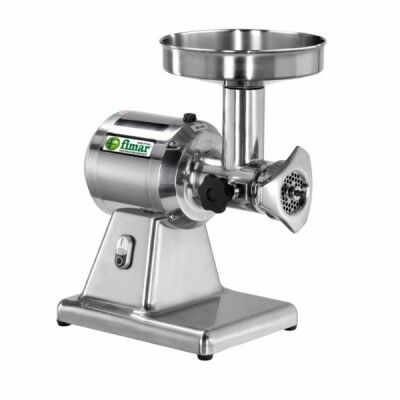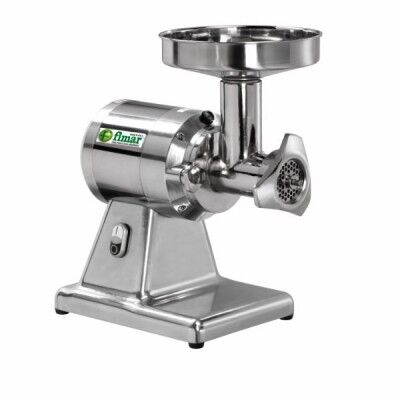Meat Grinders
In this category, you’ll find professional meat grinders suitable for commercial operations (series 12 – 22 – 32), such as butcher shops, delis, restaurants, and hotels, as well as more compact models (series 8) designed for home use. The grinding unit material can be chosen from food-grade cast iron, anodized aluminum, or AISI304 stainless steel.
The standard grinding plates are made of stainless steel, as are the auger and hopper, while the CE-compliant electrical controls operate at 24 volts to ensure maximum operator safety. Optional extras include grinding plates of different sizes, sausage-stuffing kits, and single-phase or three-phase power options.
Guide to Choosing a Professional Meat Grinder
Professional meat grinders can process between approximately 100 and 500 kg/hour of meat, depending on their construction features. The market offers a variety of professional meat grinders with different production capacities, voltage options, and specific cutting features tailored to various work requirements, including refrigerated models.
So, how do you choose the right professional meat grinder? Let’s look at the key factors to consider:
1) Frame Type: Exposed Motor or Enclosed Frame
- Exposed Motor Frame: This is the most common type of professional meat grinder, offering a more affordable purchase price (for the same features) compared to its enclosed counterpart. However, it is less convenient to clean.
- Enclosed Frame: Thanks to its particular design, this type allows for easier cleaning but typically comes at a higher cost.
2) Motor Power
In addition to speed of operation, professional electric meat grinders are ideal for processing large quantities of meat or tougher cuts, such as those with sinew or less tender parts. However, it’s crucial to configure the machine with the right combination of motor power, plates, and blades to achieve consistently uniform cuts, depending on the desired grinding result.
The power output of a meat grinder that can be considered professional typically ranges from a minimum of 750 watts to a maximum of 2500 watts for top-of-the-range models.
3) Choosing the Cutting System
There are three main cutting systems to consider:
a) Enterprise
b) Half Unger
c) Full Unger
One of the most important questions to ask before purchasing a professional meat grinder is: What type of ground meat do I want to achieve at the end of the process? While the operating principle is quite similar across all three cutting systems, the combination of blades and plates differs to achieve the desired result.
- a) Enterprise Cutting System:
This consists of a grinding chamber, auger, spiral blade, plate (typically with 6 mm holes), and locking handwheel. All these components rotate together to cut the meat and push it out of the grinding unit for collection, provided the correct assembly sequence is followed (as shown in the image below). The result is a medium-grain ground meat. - b) Half Unger Cutting System:
This includes the grinding mouth, auger, "0" type pre-plate, blade, 4.5 mm plate, and locking handwheel. The result is a finer grain compared to the Enterprise system. Below is the correct assembly diagram for the Half Unger system. - c) Full Unger Cutting System:
This consists of the grinding mouth, auger, "0" type pre-plate, blade, second plate, second blade, third plate, and locking handwheel (see image below). The result is a very fine grain, almost like a paste, which is often used for making sausages like frankfurters or similar products. Below is the correct assembly sequence for the Full Unger system.
4) Refrigerated Meat Grinder: Benefits
- Reduction of bacterial growth.
- Better preservation of the organoleptic properties of the processed product, as rapid deterioration of ground meat is avoided.
- Cold grinding does not affect unsaturated fatty acids, which would otherwise mix into the liquid produced during processing.
- Extended shelf life of the processed product.
- Another significant advantage: a refrigerated meat grinder can remain idle for extended periods during the day with ground meat residues inside, which can still be sold to the next customer without loss of quality.
- Ability to offer superior quality service compared to traditional meat grinders.
5) Cleaning and Maintenance
Cleaning a meat grinder is essential to ensure proper functionality and prevent bacterial growth. Generally, components like the auger, blades, and plates of a professional meat grinder are easily removable and dishwasher-safe (except for parts made of food-grade cast iron or aluminum).
6) Material Choice
When purchasing, it’s always preferable to opt for models made of stainless steel, as they are more resistant to the stresses of processing and easier to clean due to their lower susceptibility to oxidation. However, food-grade cast iron and aluminum offer a more affordable price while maintaining the same technical characteristics.
7) Accessories
When considering a professional meat grinder, it’s important to evaluate whether it can be equipped with additional accessories, which vary depending on the machine type, size, and price range.
What are the accessories for a meat grinder?
The most common accessories are perforated plates and blades, which determine the “grain size” or the texture of the ground meat. The grinding result depends on the type of blades and perforated plates through which the meat passes after being cut.
Those who work with ground meat know that different types of grinding are needed—varying in cut and thickness—depending on the desired product. Professional meat grinders allow you to swap out both plates and blades to achieve different cuts based on specific needs.
While plates and blades are essential for defining the fineness of the cut, other optional accessories can adapt the meat grinder for related functions, such as:
- Sausage-Stuffing Cones: On some series of meat grinders, optional plastic cones for sausage stuffing can be added.
- Tomato Passer: A complementary accessory, typically made of steel and aluminum, that transforms a meat grinder into a powerful tomato passer.
- Puree Maker: Another optional accessory that can turn a professional meat grinder into a potato-processing machine.
Additionally, other accessories may enhance usability, such as a pusher to feed meat into the grinder’s inlet and a collection bowl for the processed product.
8) Optional Features Available for Professional Meat Grinders
- Food-grade cast iron grinding unit
- Stainless steel grinding unit
- Fully removable grinding unit
- Reverse function
- Enterprise grinding system
- Unger grinding system
- Single-phase or three-phase power supply
- Product refrigeration
Conclusion: How to Choose the Best Meat Grinder for Your Needs
Let’s summarize the most important factors:
The price of a meat grinder is influenced by several key factors:
- Power output
- Cutting system types
- Material choice: stainless steel, aluminum, or food-grade cast iron
- Range of installed features
- Accessories
- Manufacturer brand
With this guide, you now have the information needed to find the solution best suited to your needs!

